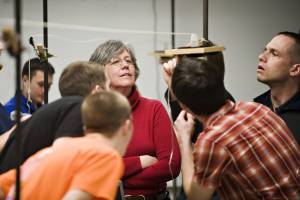You are here: start » activities » guides » wvstringwaves
Navigate back to the activity.
Dispersion Relation for Waves on a String: Instructor's Guide
Main Ideas
- Dispersion Relation
- Resonance
- Material Velocity
- Phase Velocity
Students' Task
Estimated Time: 15 minutes
To find the dispersion relation for waves on a light string by plotting the angular frequency of the waves as a function of wave vector. In class, there is a discussion of the linearity of the relation, and of the relevance of “wave velocity” for standing waves. For homework, the students complete the sheet and compute the wave velocity from the measurement of the slope, and from the tension and mass density of the string.
Prerequisite Knowledge
- Basic wave properties: wavelength, angular frequency, and wave speed.
Props/Equipment
- light string ( 2m in length)
- device for generating waves (we use a speaker cone hooked up to a function generator)
- something to hold up the string (we use ring stands)
- a weight to keep the string under tension
- meter stick
- instructor has Excel worksheet on display graph of students' results wvstringwaves.xlsx
- (optional) handout
Activity: Introduction
A brief mini-lecture that reminds students of what they know about how to measure wavelength and angular frequency, and how these quantities are related to wave speed. We also mention and distinguish two relevant speeds: the wave speed (phase velocity/group velocity) and the material velocity.
Activity: Student Conversations
What happens for frequencies where a half integer number of wavelengths does not “fit” the rope?
What is k? Why do we use it? Do we measure k or frequency?
Students enter their values for frequency (measured from function generator) and k (derived from number of nodes and length of rope) into an Excel spreadsheet which is displayed on a screen for all to see. A graph of f vs. k appears in real time. The points usually fall on a line, but invariably, there is a measurement error, which one group will catch and there is discussion about why there is an outlier and whether it is legitimate to “throw” away an experimental datum. (Often, the reason is that some group count the end points as nodes, while others don't. Sometimes, it's simply an error in recording.) Once, there were two distinct lines (different slopes), and as a group the class decided that the ropes in different experiments were different. (They were the same, but the tension applied in the two cases was not the same, which leads to a similar phenomenon.) The process of discovering the reason for the differences was useful.
Activity: Wrap-up
Each group enters results for a particular mode into the spreadsheet. There are duplicate measurements from different groups; this is good. Reproducibility is important. Once the results are in, students are asked for comment.
There are always outlier points. The students recognize these and must resolve them before discussion continues. A discussion of reproducibility in experiments and what constitutes acceptable error in this particular experiment ensues, and is useful.
The linearity of the $\omega$ vs. k plot is noted. Ask if it is expected from the form of the wave equation just studied. What information does the value of the slope hold? Once the students conclude that it is indeed the velocity of propagation ask whether the waves they measured propagated (they didn't, they were standing waves). This leads to a discussion of the fact that a standing wave is an equal superposition of a left- and a right-propagating wave. Ask them to demonstrate this mathematically if it has not already been exhausted in previous classroom discussion.
Students are asked to give examples of similar situations - propagation of light is sometimes volunteered, and then someone will ask about propagation in a medium. This can lead to a discussion of refractive index, anomalous dispersion and other light-related phenomena.
Someone usually mentions sound waves, and this is a good opportunity to talk about propagation in elastic media and phonons. Here one can mention that the linearity fails in systems where the wavelength approaches the discreteness of the system - in a beaded string for example, which they will study in periodic systems. Also in solids - Bragg reflection of electrons.
Water wave systems are strongly dispersive. Sometimes the topic of solitons comes up.
Whatever examples come up, it is important to formally introduce the terms “dispersive” and “non-dispersive” to indicate that the velocity of harmonic waves do or do not, respectively, depend on the frequency (or wavelength). Only non-dispersive systems obey the wave equation just presented, but a plot of the dispersion relation is relevant for any system, and such systems are described by other wave equations.
Ask the students to draw dispersion relations where the velocity increases (decreases) with frequency (or wavelength). Ask them to find other examples for homework. The students never, in my experience, bring up quantum mechanical systems, but it can be pointed out that they will encounter this important dispersive system within a few sessions.
As an example, consider the following two sets of data, (2011) and (2010). Note that the data from 2011 was cleaned up during class.
